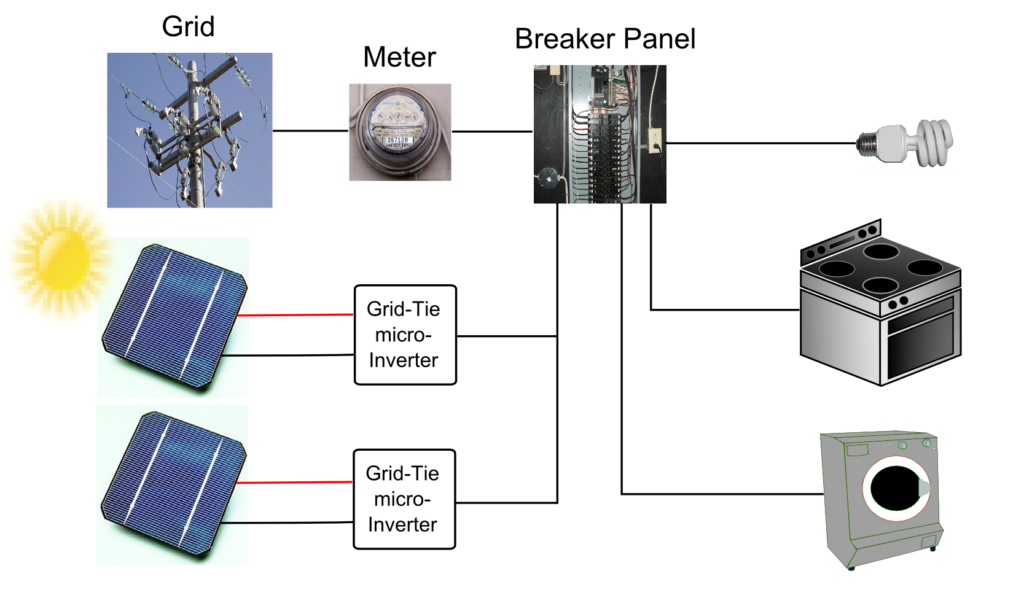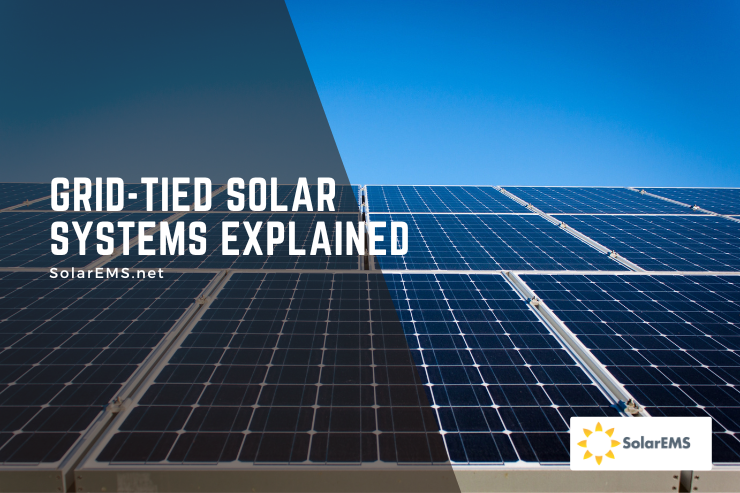If you are thinking about making a shift towards renewable energy then installing a solar system for your household is the only thing that will come to your mind. However, do you know how many types of solar systems are available in the market? Well, I do and the answer is three. These are namely:
- Grid tied solar system
- Off-grid solar system
- Hybrid or backup power solar systems
Grid Tied
Solar System
- Connected to the utility grid.
- Use grid-power as backup power when the solar panels are not producing enough electricity.
- These systems do not have battery storage and excess energy produced by the panels is fed back into the grid.
Off-Grid
Solar System
- Off-grid solar systems are not connected to the utility grid.
- They rely solely on the energy produced by the solar panels and stored in batteries.
- They are typically used in remote areas where access to the grid is not available.
Hybrid
(Backup Power) Solar Systems
- Hybrid or backup power solar systems combine elements of grid-tied and off-grid systems.
- They are connected to the grid but also have battery storage to provide backup power during grid outages.
- These systems can switch between grid power and solar power as needed to ensure a continuous supply of electricity.
- Hybrid systems can also have other power generation sources like wind and water to generate power as backup.
Just like you have seen in the title of this article we will focus mainly on the grid tied solar system and discuss everything related to this particular type of solar system.
About grid tied solar system
Whenever you imagine or think about a solar system what comes to your mind? Multiple solar panels are lighting your house, right? But things are not so simple. The grid tied solar system as the name suggests is a kind of solar system where the entire system is linked with the electrical grid (near your house) and the excess power that is generated from the solar system gets transferred to the grid.
Now, do you know why grid assisted solar systems are so popular among homeowners? It comes with lots of advantages and more importantly, the entire system can be extremely inexpensive in comparison to an off-grid system. You won’t have to worry about electricity running out because it will automatically adjust with the supporting system to offer you seamless connectivity. The excess electricity that your solar system produces will directly get transferred to the grid which can also give you credit from your electricity provider.
How does a grid tied solar system operate?
Due to its immense popularity, you may question what is so special about grid tied solar systems. Well, the answer is very simple. In a grid tied solar system, the functioning of the solar panels remains the same. They generate electricity which ultimately powers up your home but if your solar panels do not get any sunlight due to natural reasons, the connected grid will supply you with electricity.
Similarly, at times if you generate more electricity that surpasses your household requirements then the extra amount of electricity will be transferred directly to the electricity grid. Normally, this option gives your household enough ‘energy credits’ so that you won’t have to pay any utility bills even if you use the grid electricity (sometimes).

The pieces of equipment required for a grid tied solar system
Do you think that installing solar panels is a very complicated and stressful process? Don’t worry about it because you can always install a grid tied solar system which has the easiest installation process. To build the entire solar system you will need the minimum number of equipment and you won’t have to worry about any kind of wiring. Let us have a look at the different components of a grid connected solar system:
Grid assisted solar inverter
Grid assisted solar inverter is one of the primary components of the grid tied solar system. It helps in converting the DC current to the AC current (which has been generated from the solar panels). The inverter also evaluates the output of solar energy to determine if the energy needs to be utilised for household usage or if it needs to be transferred to the grid.
Net meter
A net meter is the second most important piece of equipment you need while installing a grid tied solar system. With a net meter, the two-way power exchange can happen and it also monitors the electricity level between both connections.
Racking and mounting
With the help of this equipment, the solar panels can be installed in their designated place, and create a ventilation system that allows the cooling of the panels.
Wiring
Wiring helps in transferring the energy from solar panels to the grid assisted solar inverters. From there on the energy is supplied to the home and the net meter.
Solar panels
Solar panels help in generating electricity which we know as DC or direct current. For example, if you are thinking about installing a 6 kW solar system then you will have to install around 15 panels of 400 watts.
Difference between off-grid and on grid solar system
You must be wondering if I install an off-grid system would it even matter? Yes, it would matter a lot because there are lots of benefits of installing a grid tied solar system in comparison to the off-grid solar system. For starters, you will be able to save your money on electricity bills and more importantly, receive credits from your electricity supplier.
You won’t have to invest your money and purchase costly batteries to save the excess electricity and directly sell the excess energy to your electricity supplier with the help of a net meter. This equipment will also help you keep track of your electricity usage as well as the amount of electricity you have supplied to the grid.
You will be at a disadvantageous position if you don’t have enough battery backup and the sun does not come for multiple days or even weeks. For example, during monsoon a lot of times you may not receive sunlight for 7 to 10 days which will create huge trouble for you if you are using an off-grid solar system.
In another case, the battery storage of the off-grid battery system has a limit and that is why if your battery becomes full then the excess energy produced through your solar panels would be wasted. Overall, the grid tied solar system is the most environment-friendly option for homeowners.
The return on investment of grid tied solar systems is quicker and long-lasting
Are you concerned about solar system investments? You don’t have to worry about it because installing a solar system is extremely beneficial for homeowners in the long run. Furthermore, if you choose to invest in a grid tied solar system then you will receive your return on investment faster than anticipated.
Do you know what the average life expectancy of a solar system is? It is around 25 years and if you compare the payback period of the different solar systems then your investment will reach the break-even point within 8 to 10 years if you are using a grid tied solar system.
All of this indicates that you will be able to enjoy the benefits of the solar system for at least 15 years. Whereas this time period will get reduced if you are using a hybrid system or off-grid system.
Now, the return on investment (ROI) for a grid-tied solar system depends on several factors including:
- System size: Larger systems usually have a lower cost per watt and a higher ROI.
- Location: The amount of sunlight received and the cost of electricity from the grid, both of these play an important role in the ROI of a solar system.
- Installation costs: Although the cost of installation, permits, and inspections is a one-time investment, but it can impact the overall ROI of the system.
- Incentives: Government incentives, such as tax credits and rebates, can significantly increase the ROI of a solar system. But then again, it varies on where you are living and the policies associated with your state and electricity supplier.
As a homeowner, you should check out other monetary aspect of the solar system which is related to the maintenance of the system. The maintenance requirement for the grid tied solar system is extremely low which makes it a great choice for homeowners.
Final words
Grid tied solar systems do not need batteries during the installation process and that is why it is extremely cheap in comparison to any other type of solar system. More importantly, you get credit for the extra electricity you are producing through your solar panels.
Grid tied solar systems also have the capacity to offer you a return on investment quicker and that is why a lot of people who want to purchase and install solar systems at their homes opt for grid tied solar systems.
Frequently asked questions
Which is better grid-tied or off-grid?
The grid tied solar system is the most popular solar system because of its relatively low operational and installation cost. If you are someone who is living near a power grid then grid tied solar systems can be extremely helpful for you. On the other hand, off-grid solar systems are costly because they require additional gas generators and batteries.
Is grid-tied the same as hybrid?
No, grid tied solar systems are completely different from hybrid solar systems. Although their setup is similar to that of a grid tied solar system they also come with battery storage which means you can use the electricity generated from the solar panels when there is no sunlight available.
Do grid-tied systems use batteries?
Grid tied solar systems do not use batteries instead they directly convert the energy generated from solar panels into DC or direct current. Although the system uses an inverter it is cheaper than any other type of solar system because of the fact that it does not use batteries. Solar batteries are the most expensive component.
Which type of inverter do we use in a grid tie solar system?
In a grid tied solar system you will have to use a PV inverter that can work with solar PV energy. With the help of a PV inverter, the direct current can be transformed into an alternating current.
What happens when off-grid solar batteries are full?
In an off-grid solar system when the battery becomes full then it automatically stops absorbing energy from the solar system. Although the solar panels will continue to produce electricity, that electricity will not be stored in the battery unless there is any space available.
In this article, we have all the essential information related to a grid tied solar system, its components, why is it so popular, and what makes the system unique from other solar systems the FAQs have been taken from Google’s ‘People also ask’ section which is why they are extremely relevant to the content.
Meet the Authors
Dax Linwood is a knowledgeable and experienced writer in the field of renewable energy, with a core expertise in solar energy. With a passion for sustainability and a commitment to advancing the adoption of clean energy, Dax's writing is both informative and engaging. He has worked on numerous solar energy projects, including solar panel installation and maintenance, and has a deep understanding of the technology and its benefits. Dax's expertise and dedication to the renewable energy industry make him a valuable resource for those looking to learn more about solar energy and its impact on the environment.

